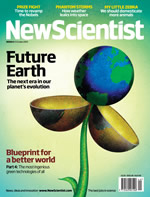A sprinkling of nanotubes makes plants shoot up
 TINY they may be, but carbon nanotubes have found a remarkable range of uses, from stretchy loudspeakers to artificial photosynthesis. Now use as a fertiliser can be added to the list.
TINY they may be, but carbon nanotubes have found a remarkable range of uses, from stretchy loudspeakers to artificial photosynthesis. Now use as a fertiliser can be added to the list.Plant biologist Mariya Khodakovskaya and nanotechnologist Alexandru Biris, both at the University of Arkansas at Little Rock, planted tomato seeds in a growth medium that contained carbon nanotubes. They found that the seeds germinated sooner and seedlings grew faster than those in a non-treated medium (ACS Nano, DOI: 10.1021/nn900887m).
Nanostructures have been reported to boost germination before, but no explanation for the phenomenon has been offered until now. The pair noticed that the nanotubes appear to penetrate the thick seed coat, which would allow water to enter the dry seeds more rapidly. This could explain how they boost germination, Khodakovskaya says.
The experiment involved placing 270 sterile tomato seeds in a growth medium that contained carbon nanotubes in concentrations ranging from 10 to 40 micrograms per millilitre. A control group consisted of 90 seeds in a nanotube-free growth medium.
After three days none of the control seeds had germinated, but more than 30 per cent of the nanotube-exposed seeds had begun to sprout. The effect was more pronounced after 12 days; by that time an average of 32 per cent of the control seeds had germinated, compared with more than 70 per cent of the nanotube-supplemented seeds.
Four weeks into the experiment, nanotube-fed seedlings were twice as tall and had more than twice the biomass of the control seeds, although the root systems were similarly developed in all seedlings.
Trials on other plant species are now planned, the two say. “We think that nanomaterials definitely have potential for use as fertilisers for a number of plant species, especially for non-food plants,” they told New Scientist.
Other researchers remain cautious, however. While Alejandro Pérez de Luque at the Institute for Sustainable Agriculture in Córdoba, Spain, is convinced by the results, he is not persuaded by the proposed mechanism. “Seed germination is a complex process and I am not sure that seed imbibition of water explains the differences,” he says.
The elongated stems of the seedlings exposed to nanotubes may indicate abnormal growth patterns due to hormonal imbalance, Pérez de Luque says. “I would like to see the plants when they reach maturity, because long internodes [stretches of stem between branching points] indicate that plants are not growing properly.”
Ken Donaldson at the University of Edinburgh in the UK warns that even if nanotubes did become cheap enough to use as a fertiliser, safety could be an issue. Last year, Donaldson found that carbon nanotubes trigger toxic effects in mice similar to those associated with asbestos fibres.
You can return to the main Market News page, or press the Back button on your browser.

